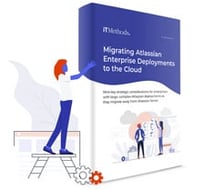As we are getting closer to the announced end-of-life date for Atlassian Server, February 2024, your company might find itself scrambling to find the best solution on how to migrate Atlassian deployments to the cloud.
Cloud migration often proves to be a complex affair. So how do you ensure your organization has a smooth and successful migration journey with minimal disruption to your current operations? The answer lies in deliberate planning and choosing the right strategy that suits the needs of your organization.
In a recent webinar, Benjamin King, Solutions Engineering Manager at Atlassian, and Ivan Lima, Senior Consultant and Atlassian Functional Consulting Lead at iTMethods, shared some insights on the 3 common migration strategies.
1. Big Bang Approach
As the name suggests, this migration approach is about moving data from the legacy to the target system “all at once”. The Big Bang Approach can be split up into two categories:
1.1 Optimize and Shift
 The Optimize and Shift method allows you to optimize and transfer the data you actually need, all at once. Sitting somewhere between the Start Fresh and the Lift and Shift approaches, this is the strategy most organizations use since it allows them to abandon whatever isn’t working and improve upon what is essential.
The Optimize and Shift method allows you to optimize and transfer the data you actually need, all at once. Sitting somewhere between the Start Fresh and the Lift and Shift approaches, this is the strategy most organizations use since it allows them to abandon whatever isn’t working and improve upon what is essential.
Before the migration, your team conducts a detailed audit on what data is important to keep and clean up in order to eliminate hidden legacy data challenges and avoid migrating unused or unwanted data that is rarely accessed. This in turn allows you to set up your cloud site, taking advantage of new capabilities and updates – while leaving the inefficient aspects of your old instance behind.
1.2 Lift and Shift
 This approach is ideal for customers who want to keep and transfer all data to the new cloud environment in a single downtime window. For instance, if finishing current projects prior to the migration is unmanageable, and all the data in your instance is relevant to your current business, you may opt for this method.
This approach is ideal for customers who want to keep and transfer all data to the new cloud environment in a single downtime window. For instance, if finishing current projects prior to the migration is unmanageable, and all the data in your instance is relevant to your current business, you may opt for this method.
Lift and Shift allows you to enjoy a shorter overall migration time since everything is migrated at once. However, this approach does include some risks since some features and apps might not be compatible, and so does their respective data, given the differences between server and cloud products. For example, you may find yourself in a situation where the apps your team currently uses are not available in the cloud (although it is possible to find equivalents).
2. Phased Approach
A phased approach allows you to migrate data from your Server to Atlassian Cloud in defined stages – rather than all at once. It is a more deliberate approach since each increment of data or update undergoes ongoing testing to detect and resolve bugs before the next phase occurs.
With this method, your organization can transfer all data in phases, which in many cases is more time-consuming and complex. It is recommended to evaluate data in more detail and decide what is essential for your current business and what areas need improvement. With a deliberate clean-up of your data, you can set up your cloud site, taking advantage of new capabilities and updates – while leaving the inefficient aspects of your old instance behind.
3. Start Fresh
 If you are confident you can leave your existing server project data behind going forward, then you may opt for the Start Fresh approach. For example, if your company uses Jira and you know that a team no longer requires access to old projects/issues, you can choose this strategy.
If you are confident you can leave your existing server project data behind going forward, then you may opt for the Start Fresh approach. For example, if your company uses Jira and you know that a team no longer requires access to old projects/issues, you can choose this strategy.
This approach is also a good choice if you are building up a new team, or need to start working in the cloud immediately. It provides an opportunity to rapidly migrate to the new environment and revisit your current data and migration planning with more information about your organization’s needs. However, with this approach, you need to consider that after the migration, accessing old projects/space data won’t be available in the new Cloud environment.
iTMethods Recommendation
iTMethods recommendation aligns with Atlassian. Assuming customers can migrate in a single downtime window, we recommend the Optimize and Shift approach with a detailed audit on what data needs to be migrated to ensure unwanted and unused data will be left behind. Whichever strategy aligns with your organizational goals, iTMethods' team of certified experts is here to help.
 We are an authorized Atlassian Gold Enterprise Solution Partner with over 15 years of experience as a Managed Service Provider (MSP). We can help you migrate your on-premises Atlassian applications, add-ons and integrations to Atlassian Cloud or our Managed DevOps SaaS Platform.
We are an authorized Atlassian Gold Enterprise Solution Partner with over 15 years of experience as a Managed Service Provider (MSP). We can help you migrate your on-premises Atlassian applications, add-ons and integrations to Atlassian Cloud or our Managed DevOps SaaS Platform.
Get in touch today to see how we can help you on your migration journey!
Ask our Experts
Whitepaper: Migrating Atlassian Enterprise Deployments to the Cloud

Considering how to migrate your Atlassian Enterprise deployment to Cloud? Is Cloud or Data Center your best option? Moving off Server?
Whether you have more questions than answers, currently assessing the best Cloud option for your business, or looking for some best practices, this whitepaper is for you.